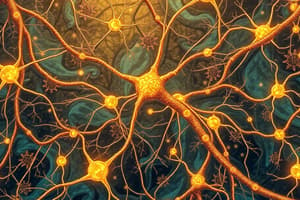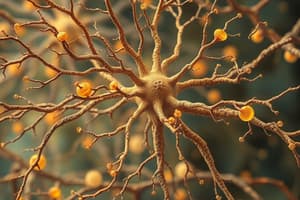Podcast
Questions and Answers
Which of the following best describes the role of Helper T cells in the immune response?
Which of the following best describes the role of Helper T cells in the immune response?
- Engulfing and digesting pathogens, similar to macrophages.
- Destroying infected body cells by recognizing foreign antigens.
- Activating B cells and Killer T cells to mount a coordinated immune response. (correct)
- Producing antibodies to directly neutralize pathogens.
What is the key difference between active and passive immunity?
What is the key difference between active and passive immunity?
- Active immunity involves the transfer of antibodies from another source, while passive immunity results from the body producing its own antibodies.
- Active immunity results from exposure to an antigen, while passive immunity is unrelated to antigen exposure.
- Active immunity provides immediate protection, while passive immunity requires a few days to develop.
- Active immunity is lifelong, while passive immunity is temporary. (correct)
After a successful vaccination, which type of immune cell is primarily responsible for providing a rapid response upon subsequent exposure to the same antigen?
After a successful vaccination, which type of immune cell is primarily responsible for providing a rapid response upon subsequent exposure to the same antigen?
- Memory B cells. (correct)
- Helper T cells.
- Plasma cells.
- Macrophages.
During a primary immune response, a macrophage engulfs a pathogen. What is the MOST important subsequent step performed by the macrophage to activate the adaptive immune system?
During a primary immune response, a macrophage engulfs a pathogen. What is the MOST important subsequent step performed by the macrophage to activate the adaptive immune system?
Which of the following represents the most effective strategy for long-term protection against a specific pathogen?
Which of the following represents the most effective strategy for long-term protection against a specific pathogen?
Which component of a neuron is primarily responsible for receiving signals from other neurons?
Which component of a neuron is primarily responsible for receiving signals from other neurons?
What is the primary role of the myelin sheath that surrounds the axon of a neuron?
What is the primary role of the myelin sheath that surrounds the axon of a neuron?
During the transmission of an electrical impulse along a neuron, what ion is primarily responsible for the depolarization phase of the action potential?
During the transmission of an electrical impulse along a neuron, what ion is primarily responsible for the depolarization phase of the action potential?
At a synapse, what is the role of neurotransmitters?
At a synapse, what is the role of neurotransmitters?
In a reflex arc, which type of neuron is responsible for directly triggering a response in a muscle or gland?
In a reflex arc, which type of neuron is responsible for directly triggering a response in a muscle or gland?
Which of the following describes the sequence of events in a typical reflex arc when you touch a hot surface?
Which of the following describes the sequence of events in a typical reflex arc when you touch a hot surface?
What distinguishes nonspecific defenses from specific defenses in the immune system?
What distinguishes nonspecific defenses from specific defenses in the immune system?
Which of the following is an example of a nonspecific defense mechanism?
Which of the following is an example of a nonspecific defense mechanism?
Flashcards
Phagocyte
Phagocyte
Cell that engulfs and digests pathogens.
Helper T Cell
Helper T Cell
Activates B and T cells to initiate immune response.
Primary Response
Primary Response
Initial immune reaction to a pathogen, takes time.
Memory B Cell
Memory B Cell
Signup and view all the flashcards
Active Immunity
Active Immunity
Signup and view all the flashcards
Neuron
Neuron
Signup and view all the flashcards
Dendrites
Dendrites
Signup and view all the flashcards
Axon
Axon
Signup and view all the flashcards
Myelin Sheath
Myelin Sheath
Signup and view all the flashcards
Action Potential
Action Potential
Signup and view all the flashcards
Neurotransmitters
Neurotransmitters
Signup and view all the flashcards
Reflex Arc
Reflex Arc
Signup and view all the flashcards
Nonspecific Defenses
Nonspecific Defenses
Signup and view all the flashcards
Study Notes
Nervous System
-
Neuron Structure: Neurons are the basic units for signal transmission. They have dendrites (receive signals), a cell body (processes information), an axon (transmits impulses), a myelin sheath (insulates the axon), axon terminals (release neurotransmitters), and synapses (gaps between neurons).
-
Impulse Transmission: Neurons transmit impulses electrically. Resting neurons have a negative internal charge. Stimulation causes sodium (Na⁺) influx, reversing the charge (depolarization). This signal travels down the axon (action potential). Potassium (K⁺) efflux restores the negative charge (repolarization). The sodium-potassium pump restores the neuron's resting state.
-
Chemical Transmission: Neurotransmitters are released into the synaptic cleft at the axon terminal. These neurotransmitters bind to receptors on the next neuron's dendrites, initiating another action potential. Signals can be excitatory (starting another impulse) or inhibitory (stopping).
-
Reflex Arc: A reflex arc is a rapid, involuntary response. A sensory neuron detects a stimulus, which is processed by an interneuron in the spinal cord, and a motor neuron triggers a response (e.g., pulling your hand away from a flame) before the brain intercepts the signal. The three types of neurons are sensory, interneurons, and motor neurons.
Immune System
-
Nonspecific vs. Specific Immunity: The immune system has two types of defenses: Nonspecific (skin, mucus, inflammation, fever, phagocytes) and Specific (lymphocytes like B and T cells).
-
Immune Cells and Molecules: Key immune cells include phagocytes (engulf pathogens), NK cells (destroy infected cells), macrophages (large phagocytes), helper T cells (activate B and T cells), memory B cells (fast response to reinfection), antibodies (bind to antigens), plasma cells (antibody producers), and killer T cells (destroy infected cells).
-
Antigen and Immune Response: Antigens are foreign substances triggering an immune response. Macrophages engulf pathogens, presenting antigens. Helper T cells recognize antigens and activate both B and T cells. B cells produce antibodies, and killer T cells eliminate infected cells. Memory B cells remain for future, faster reactions.
-
Primary vs. Secondary Response: The first encounter with a pathogen causes a slower primary immune response. Subsequent encounters cause a faster, stronger secondary response due to memory B cells.
-
Types of Immunity: Permanent immunity is life-long. Active immunity results from the body producing antibodies (through infection or vaccination). Passive immunity involves receiving antibodies from another source (e.g., breastfeeding).
Studying That Suits You
Use AI to generate personalized quizzes and flashcards to suit your learning preferences.




